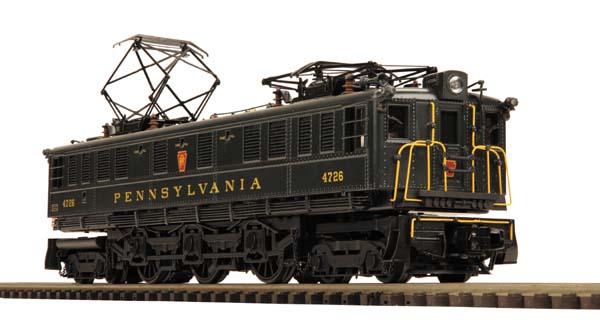
August 13, 2008 - Although Milwaukee Road and New Haven fans might argue otherwise, Pennsy fans would contend that the Standard Railroad of the World was the greatest electrified railroad of them all. Surely no other American road had a larger or more varied fleet over the years ラ and M.T.H. has modeled more Pennsy electrics than any other O gauge manufacturer, from the noble but flawed モBig Lizヤ FF1 to the mighty GG1, perhaps the best electric the world has ever seen.
Check out the P5a in Taylor's latest Product Update VIDEO.
This week weメre shipping our newest Pennsylvania モjuice jack,ヤ the box cab P5a. While it toiled in the shadow of the famous streamlined GG1, the humble P5a was the mainstay of Pennsy freight service, and our model duplicates this workhorse in superb detail.
Premier-level details
From the rails up, our full-scale 1/48 models are superbly detailed. The underframe accurately duplicates the prototypeメs springs and brake rigging, and end trucks feature safety chains intended to minimize damage in the event of a derailment. As on the prototype, the center set of spoked drivers is モblind,ヤ or without flanges, to allow the engine to negotiate tighter curves. Air and sand pipes are separately applied detail parts.
Above the wheels, the modelメs die-cast body beautifully captures the utilitarian, riveted look of the Pennsyメs most numerous boxcab, and includes glazed windows with windshield wipers, separately added ventilators, numerous handrails, and Pennsy paint schemes accurate down to the smallest details ラ including labeled sand fill hatches and legible builders plates. Lighting includes headlights, illuminated number boards, and lighted marker lights.
The busy roof of the prototype electric is accurately rendered as well. Operating pantographs raise and lower according to the direction of travel, with the rearward pantograph in the モupヤ position. Other rooftop details include insulators and electrical cables, bell and horn, and lift rings to allow shop crews to remove roof panels.
Operating features
Thanks to Proto-Sound 2.0 and DCS, our model runs as well as it looks. Open a Proto-Coupler, back onto a heavy freight, and pull out smoothly at speeds as low as three scale miles per hour.
As famed Pennsy author Alvin Staufer noted, モThere wasnメt a freight that a trio of P5aメs couldnメt pull,ヤ and you can duplicate that operation as well. DCS allows you to easily build a lashup of two, three, or more P5aメs to model heavy freight service ラ or highball down the mainline with a lone P5a and a passenger train as these engines did when they were first built. If you own the streamlined モmodifiedヤ P5a we produced earlier, you can also duplicate the Pennsyメs double-heading practice of running the modified engine in front whenever possible, because it afforded better protection for the crew.
Our model is available in four numbers, two with passenger sounds and two with freight sounds. However, you can easily change a passenger engine to freight service or vice versa by downloading a new sound set over the Internet ラ another feature thatメs unique to DCS.
Historical Background
Conceived in 1931, the Pennsyメs P5a was intended to be the last step in the search for a mainline モjuice jackヤ that had begin with the FF1 in 1917. A collaboration between General Electric, Westinghouse, and the Pennsyメs electrical staff, the design proved to be a winner. Engine crews liked the P5aメs because they were smooth, powerful, and cleaner than the K4s Pacifics they displaced on many runs. Six 625 hp electric motors geared to three axles with 72-inch drivers gave the new engine 3,750 continuous horsepower and a top speed of 90 mph on passenger runs.
But the success of the Pennsyメs passenger service proved too much for the P5a, whose limit was about 8ヨ10 cars on high-speed runs. The introduction of the GG1 in 1934 allowed the Pennsy to operate longer passenger trains with a single locomotive, and pushed the P5a into freight service ラ where it found its true calling. Regeared to a top speed of 70 mph, the P5a fleet became the backbone of electric freight service on the Pennsy for the next several decades.
The P5aメs were originally built with box cabs and, like all box cab locomotives, made engine crews a bit nervous about their exposure in an accident. After a grade crossing collision with a truckload of apples proved fatal for the crew, the final 28 P5aメs built in 1934 and 1935 were redesigned with a center cab in the image of the GG1 and labeled P5a Modifieds. In freight service, P5aメs were frequently double- and triple-headed; when available, a P5a Modified was used as the lead unit for crew safety.
Check out these newly-tooled models at your dealerメs now. We think youメll agree theyメre great-running, terrific replicas of the Pennsyメs greatest workhorse boxca as evidenced in the detail photos below.
